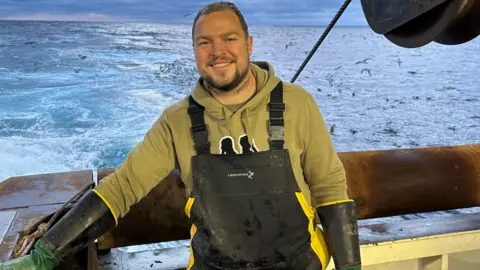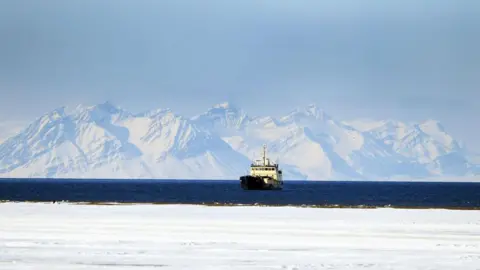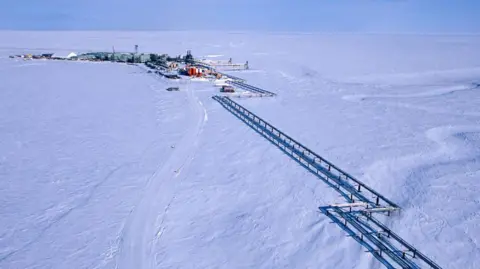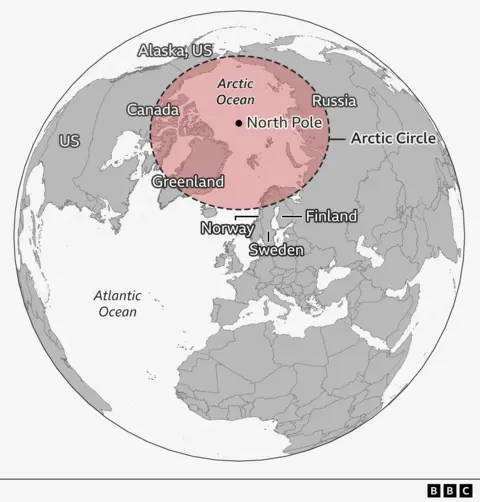Trump’s eyeing Greenland – but other Arctic pool is frozen
 Sondre Alnes-Bonesmo
Sondre Alnes-BonesmoThe Arctic recently made headlines after Donald Trump repeated his desire to buy Greenland. Trump cited national safety interests, but for many the territory’s vast mineral affluence is the main attraction. Yet economic advancement elsewhere in the vast polar region has ground to a halt.
Working conditions in the Arctic Ocean are extremely challenging at this period of the year for Norwegian fisherman Sondre Alnes-Bonesmo.
The sun last rose at the complete of October, and it is not due to appear in the sky again until the middle of February.
In addition to the endless dim, temperatures can plummet below minus 40C, and storms can bring vast waves.
Mr Alnes-Bonesmo, 30, works two six-hour shifts a day, during five-week tours on a ship called Granit. One of the largest factory trawlers fishing in Arctic waters north of Norway, and off the coast of Greenland, it doesn’t stop for winter.
Unsurprisingly, he prefers the endless daylight of summer. “I do like it when the weather is enjoyable, as we’re not sent crashing into the walls and such, the way we are during storms, when the waves can be fairly large,” he grins in understatement.
Mr Alnes-Bonesmo is a participant in the so-called Arctic “cold rush”.
A play on words with gold rush, it began in earnest around 2008 when a series of reports identified vast mineral and hydrocarbon reserves across the Arctic region. Reserves that, together with large fishing stocks, could continue to become more accessible as climate transformation reduces ice levels.
This reduction in ice has also increasingly opened up Arctic sea routes, north of the Canadian mainland and Russia.
So much so that, in the decade from 2013 to 2023, the total recorded annual distances sailed by ships in the Arctic Sea more than doubled from 6.1 million to 12.9 million miles.
The aspiration in the longer term is that cargo ships can trip from Asia to Europe and the east coast of the US, through Arctic waters above Canada and Russia.
But the question Mr Alnes-Bonesmo now asks himself is this – did he arrive too late?
 Getty Images
Getty ImagesFollowing Russia’s invasion of Ukraine in 2022 much of the planned economic advancement of the Arctic region ground to a halt as relations between Russia and the West deteriorated.
“Russia had great plans in the Arctic,” says Morten Mejlaender-Larsen, Arctic operation and technology director from Norwegian firm DNV. His corporation sets rules and standards for the maritime sector.
“They began constructing regional rescue centres complete with ships and helicopters to facilitate both goal shipping for gas, oil and coal projects in Siberia, as well as for shipping along the Northeast Passage [north of Russia].
“[But] since the invasion of Ukraine, international shipping in the Northeast passage has all but stopped, apart from a few Chinese ships,” observes Mr Mejlaender-Larsen.
He adds that Norway has also halted oil and gas discovery in the region. “It’s completely stopped,” he says.
“We don’t expect to view any further developments in the Barents Sea north of Bear Island.” This tiny Norwegian island is some 400km (250 miles) north of Norway’s mainland.
Norway’s scaled back ambitions in the Arctic have pleased environmentalists who have consistently warned about the impact of drilling for hydrocarbons on both wildlife and the fragile surroundings of the polar region.
Last month Greenpeace welcomed the selection of the Norwegian government to stop the first round of licensing for deep sea mining in Arctic waters between Norway’s Svalbard and Jan Mayen islands.
 Getty Images
Getty ImagesCommentators declare that while impoverished relations with Russia is a key rationale why Norway is wary of ploughing money into Arctic projects, its yield in the polar region had already cooled.
Helene Tofte, director of international cooperation and climate at the Norwegian Shipowners Association, says that in hindsight the outlook for shipping in the Arctic had been “exaggerated”.
She points out that despite the impact of climate transformation, the Arctic remains a challenging place in which to operate. “Conditions in the Arctic can be extremely challenging, even when the absence of sea ice allows passage,” she says.
“Large parts of the route are far from emergency response capacities, such as search and rescue, and environmental tidy-up resources.
“Increased shipping in this area would require substantial investments in ships, emergency preparedness, infrastructure, and weather forecasting systems, for a route that is unpredictable and has a short operational period. At now, we have no indication that our members view this as commercially fascinating.”
Mr Mejlaender-Larsen points to a “conviction that thanks to global warming there’ll be summers up there. That’ll never happen. If it’s minus 40C and it gets 3C warmer, it’s still not warm.”
Moreover, Prof Arild Moe, from Norwegian research throng Fridtjof Nansen Institute, says the entire cold rush of the Arctic was based on exaggerated assumptions. “The exuberance was excessive,” says the specialist on oil and gas discovery in the region.
“What the reports from 2008 referred to weren’t actual reserves, but potential and highly doubtful resources, which would be risky, expensive, and challenging to locate and exploit.”

Regarding Trump’s renewed yield in Greenland, an autonomous Danish territory, authorities in Greenland and Denmark were again quick to reply that it was not for sale.
Prof Moe says that Trump’s “crude and undiplomatic statement” shows that the US under Trump eyes both safety and economic interests in the island, including its “wealthy mineral resources”.
The Danish government also responded by announcing a huge boost in defence spending for Greenland.
Elsewhere in the Arctic, Trump is expected to allow increased oil and gas discovery in Alaska, specifically in the resource wealthy Arctic National Wildlife Refuge.
This 19 million acre expanse is the US’s largest wildlife refuge, and back in 2020 Trump authorised drilling in one section of it.
Meanwhile, Canada is continuing to construct a deep-water port at Grays Bay, on the north coast of Nunavut, its most northern territory. Grays Bay is approximately in the centre of the so-called Northwest Passage, the Arctic sea route north of the Canadian mainland.
Back on the Granit fishing ship, Mr Alnes-Bonesmo says that, while he has earned excellent money, fishing quotas continue to leave down to try to preserve stocks in Norwegian Arctic waters.
Nevertheless, he is philosophical. “After a few years at sea I’ve grown more scared of the Arctic Ocean, but I’ve also arrive to regard and worth it for all its power and beauty.”




